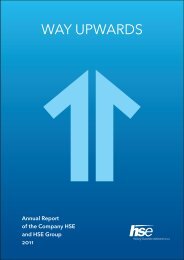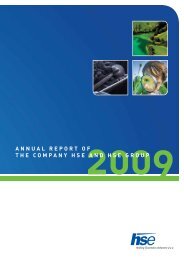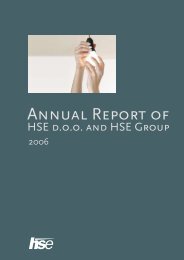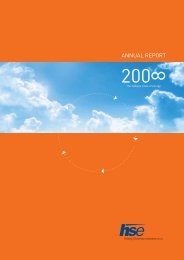Annual report - HSE
Annual report - HSE
Annual report - HSE
Create successful ePaper yourself
Turn your PDF publications into a flip-book with our unique Google optimized e-Paper software.
Costs of services are historical costs of services purchased, namely maintenance services,<br />
advertising services, entertainment, insurance premiums, payment transaction and other<br />
banking services (except interest), rentals, advisory services, business travels and similar<br />
services.<br />
Write-downs in value include amortisation/depreciation costs related to consistent<br />
transfer of value of amortisable intangible assets and property, plant and equipment.<br />
Write-downs in value also include impairments, write-downs and losses from the sales of<br />
intangible assets and property, plant and equipment as well as impairments or write down<br />
of receivables.<br />
Labour costs are historical costs that refer to salaries and similar values in gross amounts<br />
as well as duties that are calculated from this basis and are not an integral part of gross<br />
amounts.<br />
Other operating expenses occur in relation to creation of provisions, environmental<br />
charges and other duties.<br />
Financial expenses comprise borrowing costs, including related derivatives and losses<br />
from the liquidation of subsidiary. Interest expenses are recognised upon their occurrence,<br />
in the amount of agreed-upon interest rate.<br />
4.5.7.14 Tax<br />
Taxes include current and deferred tax liabilities. Current tax is included in the income<br />
statement. The deferred tax is recorded in the income statement and the statement of<br />
financial position.<br />
Current tax liabilities are based on taxable profit for the period. The taxable profit defers<br />
from net profit <strong>report</strong>ed in the profit or loss, since it excludes the items of revenue or<br />
expenses that are taxable or deductible in other years as well as items that are never<br />
taxable or deductible. The company’s current tax liabilities are calculated with tax rates<br />
that are applicable on the <strong>report</strong>ing date. Current tax liabilities decrease in the event of<br />
advance payments of corporate income tax during the year.<br />
In 2011, the applicable tax rate for corporate income tax amounted to 20%.<br />
In 2012, a change in tax rates of corporate income tax was adopted:<br />
• 2012 - 18% tax rate,<br />
• 2013 - 17% tax rate,<br />
• 2014 - 16% tax rate,<br />
• From 2015 - 15% tax rate.<br />
Deferred tax is completely disclosed using the liabilities method after the statement of<br />
financial position for temporary differences arising between the tax base of assets and<br />
liabilities and their carrying amounts in financial statements. Deferred income tax is defined<br />
using tax rates (and legislation) applicable on the date of financial position and for which it<br />
is expected to be in use when the receivable for deferred tax is realised or the liability for<br />
deferred tax is settled.<br />
A deferred tax asset is recognised if there is a possibility that a taxable profit will be available<br />
in the future, from which it will be possible to utilise temporary differences. It represents<br />
the amount of the calculated corporate income tax on deductible temporary differences.<br />
4.5.7.15 Statement of other comprehensive income<br />
<strong>Annual</strong> Report <strong>HSE</strong> 2012<br />
4 Financial Report of the company <strong>HSE</strong><br />
126<br />
The company does not present deferred taxes arising from items of other comprehensive<br />
income separately in the statement, but it discloses the amount of tax for each individual<br />
item in the explanatory notes.<br />
4.5.7.16 Cash flow statement<br />
Cash flow statement represents changes in cash and cash equivalents of the financial year,<br />
for which it is prepared. The part of cash flow statement related to operations is prepared<br />
according to indirect method, based the statement of financial position and the income<br />
statement data, while the part related to investment and financing activities is prepared<br />
using the direct method.
















